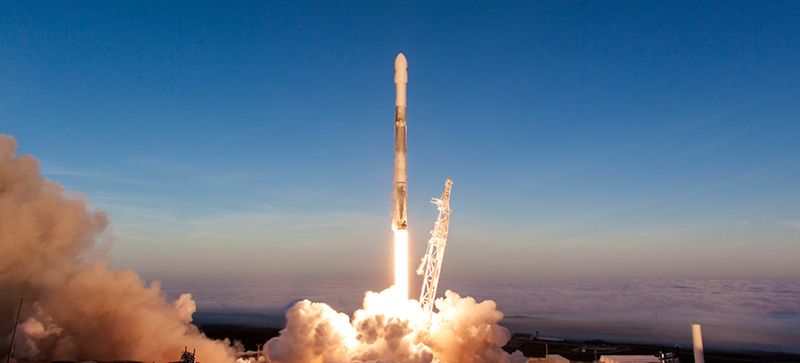SpaceX Launches Further Iridium Satellites
Iridium is a large team of satellites which surround the Earth, providing a satellite telephone communication system which covers the entire globe. The original satellites were launched toward the end of the last Century, and have been working well ever since.
It is this system which enables telephone calls to be made no matter how remote the location. People situated in remote arctic or oceanic areas far from civilisation or phone masts can use this technology in emergencies, or even to keep in touch with families and friends. You can’t use just any old mobile though – a special satellite phone is required. Nevertheless, the system has more than a million subscribers, so it’s not just polar explorers and trans-Atlantic sailors who use this technology.
The new satellites were launched earlier in the month on SpaceX’s Falcon rocket. Ten satellites were launched and released into orbit, completing a $3 billion upgrade of the Iridium satellite network. The new satellites will improve the system and provide some additional and improved features. There are now a total of seventy five satellites in total. This is more than is actually required to run the service, so that spares are available if any of the working spacecraft fail.
The additional upgrades and services should enable the Iridium company to thrive by selling more than just a simple satellite phone service. A previous operator was liquidated owing to lack of funds, but the new owners are confident that its service is economically viable.
Examples of the improved facilities include the ability to monitor aircraft movements, enabling terrestrial air traffic control agencies to improve the routing of aircraft. The resulting efficiency savings could save millions of tons of fuel and thereby reduce the amount of carbon dioxide, particulates and vapour trails which contribute to global warming. Pollution over urban areas may also be reduced as planes will be handled more efficiently, reducing the need for “stacking” before landing.
A further advantage of the new system is the ability to maintain information on the position of aircraft even when they are beyond radar range. This should mean that mystery disappearances of aircraft like Malaysia Airlines MH370 will become a thing of the past.
As ever with SpaceX flights, the successful launch of the Iridium satellites was only part of the story. The first stage of the Falcon 9 rocket used for the launch was actually on its second flight, it having previously used on a launch in September 2018. It again returned safely to Earth for potential re-use. It was successfully landed on a drone ship in the Pacific Ocean.
This flight is just the first in what will be a busy year for SpaceX. Further planned missions include more test flights for its new Falcon Heavy rocket; a first test for its new Dragon 2 space capsule, designed to ferry astronauts to the International Space Station (ISS), plus the debut test for its Starship prototype, intended to make human spaceflight to Mars a real possibility in the not too distant future.
SpaceX Dragon Returns to Earth
Last week also saw the successful return of SpaceX’s Dragon spacecraft from the International Space Station (ISS). It was launched on December 8th 2018, carrying around three tons of provisions, equipment and experiments to the ISS. The intervening weeks have been spent unloading the vehicle and re-stocking it with waste and returning cargo for the return trip.
The spacecraft successfully splashed down in the Pacific Ocean before it was later hauled aboard the SpaceX recovery ship and returned safely to shore. The return was especially notable because it was the first to take place at night.
SpaceX Cuts
It’s not all good news from SpaceX this week though. The financial journals have been full of reports that the company is cutting around 600 jobs. This represents around 10 per cent of its total workforce.
Using the kind of PR speak we have come to expect from more conventional companies, SpaceX president Gwynne Shotwell told her loyal workforce that the company needed to become “leaner”. “This means we must part ways with some talented and hard-working members of our team” she continued.
The problem really does seem to be one of funding. Elon Musk is a very wealthy man, but the space technology industry is an incredibly expensive field to be in. NASA has a budget of close to $20 billion per year. As a private company, SpaceX’s resources are confidential and difficult to estimate, but must be far less than this.
SpaceX earns revenue from its NASA contracts (such as ferrying supplies to the ISS) and from providing launch facilities for satellites for the US military and private contractors. But it does have very ambitious plans which will not return any revenue to the company for years, perhaps decades.
These cuts may well be an attempt to trim expenses so that the company can devote more resources to further research and development. It is also worth considering the impact of SpaceX’s re-usable technology. The company is successfully re-using its rockets, perhaps meaning that it does not need to build as many new ones as expected. This would indeed have the effect of making some of the employees involved in rocket construction surplus to requirements.
Chang’e 4 Grows Seeds on the Moon
The Chinese lunar lander has successfully managed to germinate a cotton seed on the Moon. Photographs of the seedling were posted last week. This led to one magnificent newspaper headline reporting a “Giant leaf for mankind”.
While plants have been successfully grown on the ISS before, this is the first time a seed has sprouted on the Moon. The experiment is seen as a positive sign that future lunar colonists will be able to grow their own food (and clothes), without the need for constant supplies from Earth.
Sadly, the green bud was not destined for a long life. The plant survived for only a couple of days before it succumbed to the freezing cold darkness of the lunar night. Like all plants, it relies on a comfortable ambient temperature and plenty of light. On the Moon, temperatures at night can plummet to as low as -170°C, and the darkness lasts for two Earth weeks.
Other plant seeds such as potato and cress were also sent, together with some fruit fly eggs, in the same air, water and nutrient filled canister, in the hope that a mini eco-system could be established. The Chinese have not reported on progress, but it seems unlikely that any signs of life will be found. The fortnight of frigid darkness the contents of the biosphere will experience before the lunar sunrise will surely finish them off.

